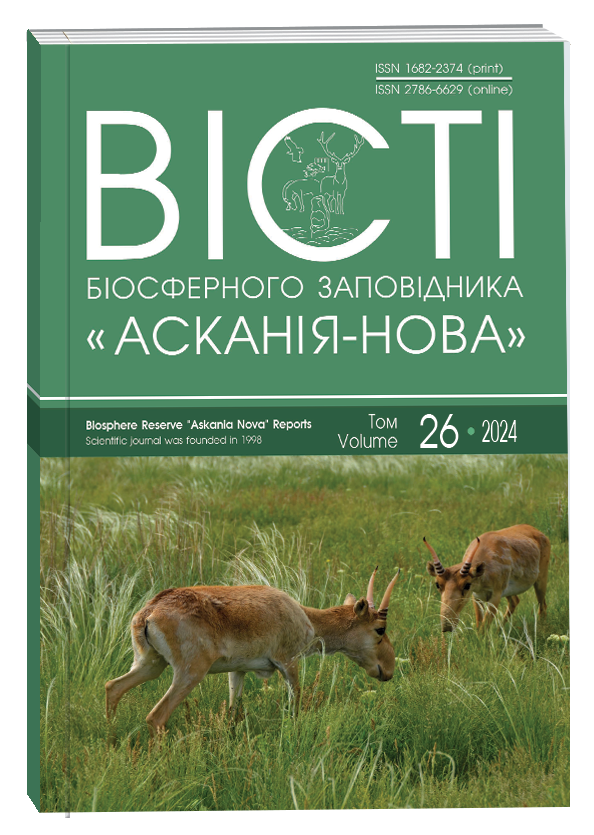TAXONOMIC STRUCTURE OF THE MYCOBIOTA OF THE KAMENYSTYI PROTECTED AREA (NATIONAL NATURE PARK "HUTSULSHCHYNA")
DOI:
https://doi.org/10.53904/1682-2374/2024-26/7Keywords:
Макроміцети, Ascomycota, Basidiomycota, чекліст, систематична структура, видове різноманіття, Покутські Карпати, УкраїнаAbstract
The article is dedicated to investigating of mycobiota in the Kamenystyi protected area (National Nature Park "Hutsulshchyna"). An analysis of the taxonomic structure of the studied areaʹs myco-biota has been conducted. A total of 251 species of fungi from 132 genera, 62 families, 17 orders, 5 classes, and 2 divisions of the Fungi kingdom were recorded. Among them, 9 species are included in the Red Book of Ukraine. The fungi in the studied area belong to orders Аscomycota and Basidiomycota. Among the Ascomycota fungi, 22 species from 17 genera, 14 families, 6 orders, and 3 classes were identified, while among the Basidiomycota, there were 229 species from 115 genera, 48 families, 11 orders, and 2 classes. The class Agaricomycetes was the most abundant in terms of species diversity with 228 species, followed by Pezizomycetes with 12 species, Leotiomycetes, and Sordariomycetes with 5 species each, and Dacrymycetes with only 1 species. An analysis of the taxonomic structure demonstrates the prevalence of four orders: Agaricales (124 species, 49.4% of the total species), Russulales (43, 17.1%), and Polyporales (23, 9.2%); 15 families: Russulaceae (34, 13.5%), Agaricaceae (16, 6.4%), Mycenaceae (14, 5.6%), Boletaceae, Polyporaceae (13 each, 5.2%), Cortinariaceae (12, 4.8%), Hydnaceae, Psathyrellaceae, Strophariaceae (8 each, 3.2%), Amanitaceae, Omphalotaceae (7 each, 2.8%), Hygrophoraceae, Inocybaceae, Marasmiaceae (6 each, 2.4%), Tricholomataceae (5, 2%); and 19 genera: Russula – 18 species (7.2%), Lactarius – 16 species (6.4%), Mycena – 14 species (5.6%), Cortinarius – 12 species (4.8%), Amanita – 7 species (2.8%), Clitocybe, Coprinopsis, Hygrophorus, Pluteus, Marasmius, Trametes, Tricholoma – 4 species each (1.6%), Cantharellus, Clavulina, Gymnopus, Hericium, Lycoperdon, Peziza, Pholiota – 3 species each (1,2%).
References
Дудка И.А., Вассер С.П. Грибы : справочник миколога и грибника. Киев : Наукова думка, 1987. C. 350–358.
Гриби заповідників і національних природних парків Українських Карпат / Дудка І.О. та ін. ; за ред. В.П. Гелюти. Київ : Наукова думка, 2019. 214 с.
Визначник грибів України. В 5 т. Т. 5. Базидіоміцети. Кн. 2: Болетальні, стробіломіцетальні, трихоломатальні, ентоломатальні, русулальні, агарикальні, гастероміцети / Зерова М.Я., Сосін П.Є., Роженко Г.Л. Київ : Наукова думка, 1979. 565 с.
Кибби Дж. Атлас грибов : определитель видов. Санкт-Петербург : Амфора, 2009. 269 с.
Леонтьєв Д.В., Акулов О.Ю. Загальна мікологія : підруч. для вищ. навч. закл. Харків : Вид. група Основа, 2007. 228 с.
Національний природний парк "Гуцульщина" : монографія / відп. ред. В.В. Пророчук, Ю.П. Стефурак, В.П. Брусак, Л.М. Держипільський. Львів : НВФ Карти і Атласи, 2013. 408 с.
Cаркина И.С. Грибы знакомые и незнакомые : справочник-определитель грибов Крыма. Симферополь : Бизнес-Информ, 2009. 416 с.
Смицкая М.Ф. Флора грибов Украины. Оперкулятные дискомицеты. Киев : Наукова думка, 1980. 224 с.
Courtecuisse R., Duhem B. Mushrooms and Toadstools of Britain and Europe. London : Harper Collins Publishers, 1995. 480 p.
Prydiuk M.P. New and little known in Ukraine representatives of the genus Cortinarius (Cortinariaceae, Basidiomycota) from Male Polissia National Nature Park. Ukrainian Botanical Journal. 2020. Vol. 77, №1. P. 16–22. The CABI Bibliography of Systematic Mycology, 2008. http://www.indexfungorum.org./Names/Names.asp.







